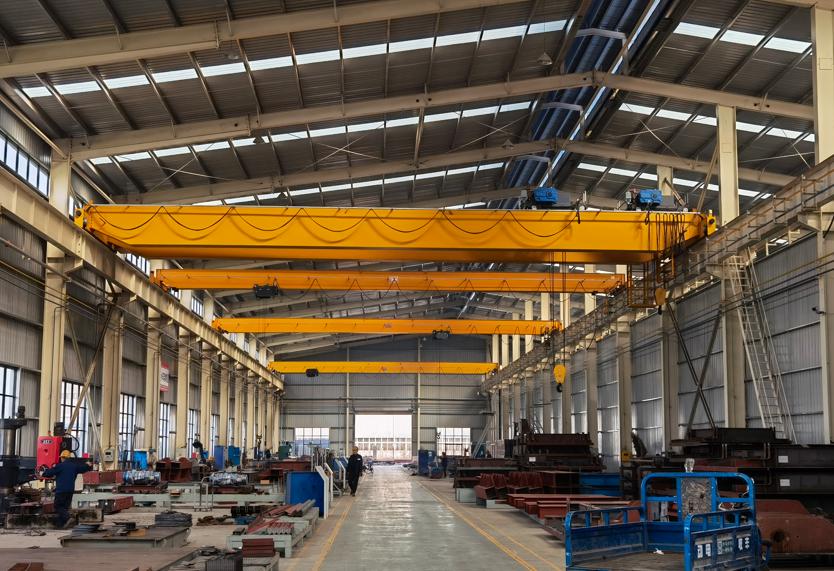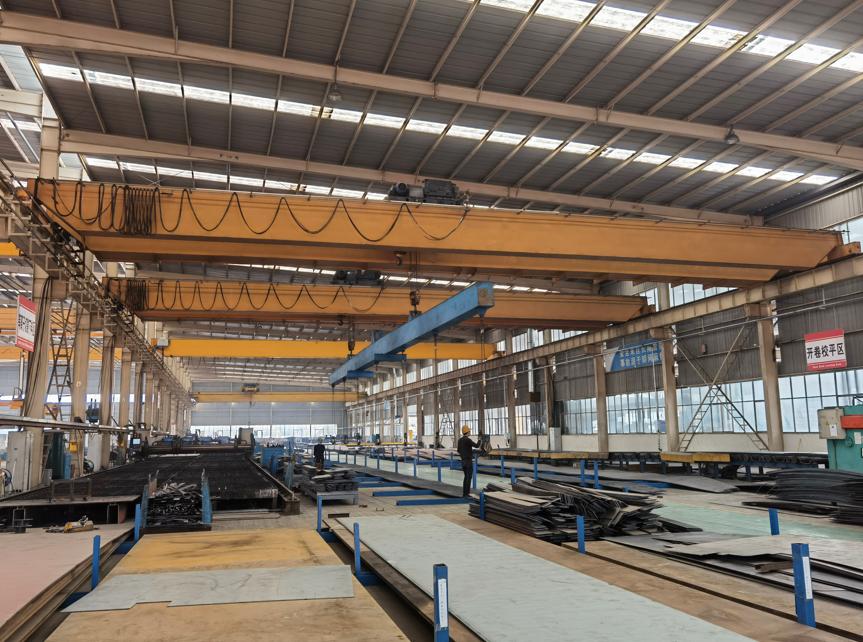4
0
0
Environmental Considerations for 50 Ton Overhead Crane Installations
9
0
In the world of heavy lifting and industrial operations, the installation of a 50-ton overhead crane is an impressive solution that enhances productivity and efficiency. However, with growing emphasis on environmental stewardship and sustainability, it is vital to consider the ecological impact of such equipment. Ensuring that these cranes are as eco-friendly as possible aligns with regulatory standards, minimizes operational costs, and supports corporate sustainability goals. Here are some key environmental considerations for the installation of 50-ton overhead cranes.

1. Energy Efficiency and Power Management
The energy consumption of a 50-ton overhead crane is significant, especially when used in high-demand environments like manufacturing plants and shipping facilities. To minimize energy usage and enhance efficiency:
Improving energy efficiency not only reduces the crane’s environmental footprint but also lowers operational costs over its lifecycle.
2. Noise Reduction Measures
Large industrial machinery like overhead cranes can produce substantial noise, which contributes to environmental noise pollution and affects both workers and the surrounding community. Mitigating noise involves:
Noise management is not only an environmental concern but also contributes to a safer, more comfortable workplace.
3. Materials and Manufacturing Process
The materials used to manufacture and install a 50-ton overhead crane affect its environmental footprint. Sustainable practices in material sourcing and production include:
Opting for manufacturers committed to sustainable production ensures a lighter environmental footprint from the very start.
4. Environmental Impact of Installation Site
The installation of an overhead crane requires careful evaluation of the surrounding environment to minimize disruptions. Considerations include:
Assessing the environmental context of the installation site is essential to ensure the crane’s presence does not harm local ecosystems.
5. Emission Control
The machinery and equipment used during crane installation can emit harmful substances, which contribute to air pollution and climate change. Implement emission control strategies such as:
Using environmentally-friendly products and equipment during installation reduces the project’s overall impact on the environment.
6. Water and Soil Protection
The installation process and operational runoff can sometimes lead to soil and water contamination, particularly in heavy industrial zones. Best practices include:
Preventing water and soil pollution is critical for maintaining the health of the local ecosystem and adhering to environmental standards.
7. End-of-Life Management
The lifecycle of a 50-ton overhead crane can span several decades, but planning for its eventual decommissioning is an important environmental consideration. Best practices include:
A sustainable end-of-life management plan helps reduce waste and limits the environmental impact of decommissioned equipment.
8. Compliance with Environmental Standards
Regulatory compliance is crucial for any industrial installation, particularly in environmentally sensitive areas. Adhering to the following standards and certifications demonstrates a commitment to environmentally responsible practices:
Meeting environmental standards helps companies protect the environment, avoid penalties, and demonstrate social responsibility to stakeholders.
Conclusion
Environmental considerations are integral to the installation and operation of a 50-ton overhead crane. By adopting eco-friendly practices, companies can reduce the environmental impact of these cranes while benefiting from cost savings, regulatory compliance, and an improved reputation. From energy efficiency and noise control to responsible waste management and sustainable end-of-life strategies, each step can contribute to a more sustainable, eco-conscious industrial future. Prioritizing these considerations ultimately aligns heavy industry with modern environmental goals, fostering a balance between productivity and ecological responsibility.

1. Energy Efficiency and Power Management
The energy consumption of a 50-ton overhead crane is significant, especially when used in high-demand environments like manufacturing plants and shipping facilities. To minimize energy usage and enhance efficiency:
- Variable Frequency Drives (VFDs): These drives regulate the crane’s speed, allowing it to adjust based on the required load and operational demands. By reducing peak power demand, VFDs lower overall energy consumption.
- Energy-Regenerative Systems: Some overhead cranes come equipped with regenerative braking systems, which convert kinetic energy into electrical energy that can be redirected to the power grid or used by other equipment in the facility.
- Idle and Standby Modes: Automated standby or power-off modes save energy during downtime by turning off non-essential systems when the crane isn’t in use.
Improving energy efficiency not only reduces the crane’s environmental footprint but also lowers operational costs over its lifecycle.
2. Noise Reduction Measures
Large industrial machinery like overhead cranes can produce substantial noise, which contributes to environmental noise pollution and affects both workers and the surrounding community. Mitigating noise involves:
- Acoustic Insulation: Installing sound-absorbing materials around the crane’s mechanical and electrical components can help reduce noise output.
- Enhanced Design and Engineering: Opt for cranes that are designed with quieter, smoother motors and brakes. Manufacturers increasingly offer designs with noise dampening as a standard feature.
- Regular Maintenance: Ensuring that components like wheels, bearings, and gearboxes are well-lubricated and free from wear reduces mechanical noise.
Noise management is not only an environmental concern but also contributes to a safer, more comfortable workplace.
3. Materials and Manufacturing Process
The materials used to manufacture and install a 50-ton overhead crane affect its environmental footprint. Sustainable practices in material sourcing and production include:
- Recyclable Materials: Steel and other metals commonly used in crane construction can often be recycled. Selecting overhead cranes that are made from or compatible with recycled materials supports circular economy principles.
- Minimizing Waste: Many manufacturers are working towards zero-waste manufacturing processes. Choosing a supplier that follows environmentally friendly production practices can significantly reduce the crane’s overall environmental impact.
- Durable Components: Cranes built with high-quality, durable components require less frequent replacement, reducing waste and resource consumption over time.
Opting for manufacturers committed to sustainable production ensures a lighter environmental footprint from the very start.
4. Environmental Impact of Installation Site
The installation of an overhead crane requires careful evaluation of the surrounding environment to minimize disruptions. Considerations include:
- Ground and Soil Health: Heavy equipment installations may impact soil quality, particularly in sites with soft ground. Ensure proper foundation work and avoid soil compaction to prevent negative effects on surrounding vegetation and groundwater.
- Environmental Sensitivity of the Site: Avoid crane installations near protected wildlife habitats or sensitive ecological zones. Work closely with environmental consultants to ensure compliance with local regulations and minimize the crane’s impact on nearby flora and fauna.
- Minimizing Construction Footprint: During installation, use eco-friendly construction techniques and materials, avoid excessive ground clearing, and implement measures to reduce dust and waste.
Assessing the environmental context of the installation site is essential to ensure the crane’s presence does not harm local ecosystems.
5. Emission Control
The machinery and equipment used during crane installation can emit harmful substances, which contribute to air pollution and climate change. Implement emission control strategies such as:
- Use of Low-Emission Installation Equipment: Opt for electric or hybrid vehicles for crane installation instead of diesel-powered machines. This helps reduce carbon emissions.
- Eco-Friendly Coatings: Apply non-toxic, eco-friendly paints and coatings to the crane to protect it from corrosion. These coatings can help prolong the crane’s life span while minimizing environmental pollutants.
- Reducing Dust Emissions: In dusty construction environments, ensure measures are in place to suppress dust, such as water sprays and barriers. This reduces particulate matter released into the air.
Using environmentally-friendly products and equipment during installation reduces the project’s overall impact on the environment.
6. Water and Soil Protection
The installation process and operational runoff can sometimes lead to soil and water contamination, particularly in heavy industrial zones. Best practices include:
- Preventing Oil and Chemical Leaks: Regularly inspect the crane’s hydraulic and lubrication systems to prevent oil leaks, which can contaminate soil and nearby water sources.
- Drainage Systems: Ensure proper drainage around the crane site to manage stormwater. Install filtration systems to capture pollutants before they enter local water bodies.
- Responsible Waste Disposal: Dispose of waste products such as lubricants, coolants, and cleaning solvents following environmental regulations to prevent soil contamination.
Preventing water and soil pollution is critical for maintaining the health of the local ecosystem and adhering to environmental standards.
7. End-of-Life Management
The lifecycle of a 50-ton overhead crane can span several decades, but planning for its eventual decommissioning is an important environmental consideration. Best practices include:
- Recyclability of Components: Choose cranes designed with recyclable parts, which can be disassembled and reused or melted down rather than sent to landfills.
- Safe Disposal of Hazardous Materials: Certain components, such as electronics and lubricants, require safe disposal methods. Partner with waste management providers specializing in industrial equipment disposal to ensure compliance with environmental standards.
- Refurbishment and Repurposing: Many parts of an overhead crane can be refurbished and repurposed. For instance, motors, cabling, and structural components can often be reused in other industrial applications.
A sustainable end-of-life management plan helps reduce waste and limits the environmental impact of decommissioned equipment.
8. Compliance with Environmental Standards
Regulatory compliance is crucial for any industrial installation, particularly in environmentally sensitive areas. Adhering to the following standards and certifications demonstrates a commitment to environmentally responsible practices:
- ISO 14001 Certification: This certification indicates a commitment to environmental management systems and minimizes a crane’s ecological impact.
- National and Local Environmental Laws: Stay updated on evolving regulations and standards that govern air emissions, noise pollution, and waste disposal. Compliance not only avoids legal consequences but also aligns operations with best practices.
- Third-Party Audits: Periodic audits by environmental consultants can help identify areas for improvement and ensure compliance with the latest standards.
Meeting environmental standards helps companies protect the environment, avoid penalties, and demonstrate social responsibility to stakeholders.
Conclusion
Environmental considerations are integral to the installation and operation of a 50-ton overhead crane. By adopting eco-friendly practices, companies can reduce the environmental impact of these cranes while benefiting from cost savings, regulatory compliance, and an improved reputation. From energy efficiency and noise control to responsible waste management and sustainable end-of-life strategies, each step can contribute to a more sustainable, eco-conscious industrial future. Prioritizing these considerations ultimately aligns heavy industry with modern environmental goals, fostering a balance between productivity and ecological responsibility.
Signatur
